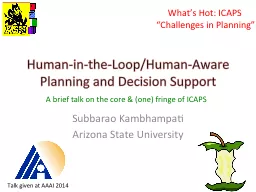

Subbarao Kambhampati Arizona State University Whats Hot ICAPS Challenges in Planning A brief talk on the core amp one fringe of ICAPS Talk given at AAAI 2014 HumanintheLoopHumanAware Planning and Decision Support ID: 624598
Download Presentation The PPT/PDF document "Human-in-the-Loop/Human-Aware Planning a..." is the property of its rightful owner. Permission is granted to download and print the materials on this web site for personal, non-commercial use only, and to display it on your personal computer provided you do not modify the materials and that you retain all copyright notices contained in the materials. By downloading content from our website, you accept the terms of this agreement.
Slide1
Human-in-the-Loop/Human-Aware Planning and Decision Support
Subbarao KambhampatiArizona State University
What’s Hot: ICAPS “Challenges in Planning”
A brief talk on the core & (one) fringe of ICAPS
Talk given at AAAI 2014Slide2Slide3Slide4Slide5
Human-in-the-Loop/Human-Aware Planning and Decision Support
Subbarao KambhampatiArizona State University
What’s Hot: ICAPS “Challenges in Planning”
A brief talk on the core & (one) fringe of ICAPS
Talk given at AAAI 2014Slide6Slide7
Planning: The Canonical View
7
A fully specified
problem --Initial state
--Goals (each non-negotiable) --Complete Action Model
The Plan Slide8
[IPC 2014 slides from
Chrpa,
Vallati & McCluskey] Slide9
[IPC 2014 slides from
Chrpa,
Vallati & McCluskey] Slide10
[IPC 2014 slides from
Chrpa,
Vallati & McCluskey] Slide11
[IPC 2014 slides from
Chrpa,
Vallati & McCluskey] Slide12
[IPC 2014 slides from
Chrpa,
Vallati & McCluskey]
Portfolio planners use a set of base planners and select the planner to use based on the problem features
Typically the selection
policy learned in terms of problem featuresSlide13
So why the continued fascination with classical planning?
..of course, the myriad applications for classical STRIPS planning
But more seriously, because classical planners have become a customized substrate for “compiling down” other more expressive planning problemsEffective approaches exist for leveraging classical planners to do partial satisfaction planning, conformant planning, conditional planning, stochastic planning etc. Slide14
Compilation Substrates for Planning
SAT
First of the substratesKautz&Selman got the classic paper award honorable mention Continued work on fast SAT solversLimited to bounded length planning
(Not great for metric constraints)IP/LP
Followed closely on the heels of SAT
Can go beyond bounded length planningAllows LP Relaxation
(Has become the basis for powerful admissible heuristics)
IP solvers evolve much slower..
(Classical) Planning
Tremendous progress on heuristic search approaches to classical planning
A currently popular approach is to compile expressive planning problems to classical planning
Conformant planning, conditional planning
(even
p
lan recognition)Slide15
Planning: The Canonical View
15
A fully specified
problem --Initial state
--Goals (each non-negotiable) --Complete Action Model
The Plan Slide16
Underlying System Dynamics
Classical
Temporal
Metric
Metric-
Temporal
Non-det
PO
Stochastic
Traditional Planning
Model Incompleteness
Pref
Dynamics
World
Model-lite Planning
[AAAI 2010; IJCAI 2009; IJCAI 2007,AAAI 2007]
Assumption: Complete Models
Complete Action Descriptions
Fully Specified Preferences
All objects in the world known up front
One-shot planning
Allows planning to be a pure inference problem
But humans in the loop can ruin a really a perfect day
Effective ways to handle the more expressive planning problems by
exploiting the deterministic planning technology
Violated Assumptions:
Complete Action Descriptions (
fallible domain writers
)
Fully Specified Preferences (
uncertain users
)
Packaged planning problem (
Plan Recognition
)
One-shot planning (
continual revision
)
Planning is no longer a pure inference problem
Model-Lite PlanningSlide17
Need for Human-in-the-Loop/Human-Aware Planning &Decision Support
Planners are increasingly embedded in systems that include both humans and machines
Human Robot TeamingPetrick et al, Veloso et al, Williams et al, Shah et al, Kambhampati et alDecision support systems; Crowd-planning systems; Tutorial planning systems
Allen et al, Kambhampati et al; LNecessitates Human-in-the-Loop PlanningBut, isn’t it just “Mixed-Initiative Planning”?..a lot of old MIP systems had the “Humans in the land of Planners” paradigm (the humans help planners)
In effective human-aware planning, planners realize they inhabit the land of humans.. Slide18
Human-Robot Teaming
18
Search and report (rescue)Goals incoming on the go
World is evolvingModel is changing
Infer instructions from Natural Language
Determine goal formulation through clarifications and questionsSlide19
Crowd-Sourced Planning
Yochan lab, Arizona State University
m
anhattan_gettingtoSlide20
Planning
: The Canonical View
20
A fully specified
problem
--Initial state --Goals (each non-negotiable)
--Complete Action Model
The Plan Slide21
Challenges in Human-in-the-Loop/Human-Aware Planning & Decision Support
Interpret what humans are doing
Plan/goal/intent recognitionPlan with incomplete domain modelsRobust planning with “lite” models(Learn to improve domain models)Continual planning/Replanning
Commitment sensitive to ensure coherent interactionExplanations/ExcusesExcuse generation can be modeled as the (conjugate of) planning problem
Asking for help/elaborationReason about the information value
Eigen SlideSlide22
Planning for
Human-Robot Teaming
22
PLANNER
Fully Specified
Action Model
Fully Specified
Goals
Completely Known (Initial) World State
Coordinate
with Humans
[IROS14
]
Replan for the Robot
[AAAI10, DMAP13]
Communicate with Human in the Loop
Full
Problem
Specification
Open World Goals
[IROS09, AAAI10, TIST10]
Action Model Information
[HRI12]
Handle Human Instructions
[ACS13, IROS14]
Assimilate Sensor Information
Sapa Replan
Problem Updates
[TIST10]
Planning for
Human-Robot TeamingSlide23
AI-MIX: System Schematic
Kartik Talamadupula - Arizona State
23
REQUESTER
(Human)
CROWD
(
Turkers
)
PLANNER
Analyze the extracted plan in light of
M
, and provide critiques
M:
Planner’s Model
(Partial)
COLLABORATIVE
BLACKBOARD
UNSTRUCTURED
STRUCTURED
Task specification
Requester goals
Preferences
Crowd’s plan
Sub-goals
New actions
Suggestions
FORM/MENU
SCHEDULES
Human-Computer
Interface
ALERTS
INTERPRETATION
STEERINGSlide24
Human-in-the-Loop Planning is m
aking inroads at ICAPS..Several papers that handle these challenges of Human-Aware Planning have been presented at the recent ICAPS (and AAAI and IJCAI)
Significant help from applications track, robotics track and demonstration trackSeveral planning-related papers in non-ICAPS venues (e.g. AAMAS and even CHI) have more in common with the challenges of Human-aware planning..so consider it for your embedded planning applicationsSlide25
AI-MIX: System Schematic
Kartik Talamadupula - Arizona State
25
REQUESTER
(Human)
CROWD
(
Turkers
)
PLANNER
Analyze the extracted plan in light of
M
, and provide critiques
M:
Planner’s Model
(Partial)
COLLABORATIVE
BLACKBOARD
UNSTRUCTURED
STRUCTURED
Task specification
Requester goals
Preferences
Crowd’s plan
Sub-goals
New actions
Suggestions
FORM/MENU
SCHEDULES
Human-Computer
Interface
ALERTS
INTERPRETATION
STEERING